Ham Thuan Bac is a mountainous district with a relatively diverse topography, the last place of the Truong Son range flowing into the sea; has a hot and sunny climate with an average temperature of 26.70 C; average rainfall: 1,300mm, the highest is 1,500mm and the lowest is 800mm in the year, which is low compared to the national level. The rainy season starts from May to October and the dry season starts from November to April next year.
2.1.1.2. Socioeconomic
The whole district of Ham Thuan Bac has 17 communes, including 2 townships, 4 plains, 7 mountainous and 4 upland communes. The total population of the district in 2006 was 149,654 people, accounting for 14.03% of the province’s population, with 74,366 men (accounting for 49.69%) and 75,288 women (accounting for 50.31%), of which the population lived In towns and townships, there are 13,597 people, accounting for 9.1% and 136,057 people living in mountainous and rural areas, accounting for 90.9%. Natural population growth rate 1.85%[33].
Total number of employees: 71,834 people, accounting for 48% of the population, the quality of labor resources is uneven. Mainly agricultural workers. The basic characteristics of the labor force are mainly unskilled, low-skilled, untrained workers, and high-skilled workers account for a low proportion. The number of scientific and technical staff is very small, in the whole district in 2000 there were 2,645 people who graduated from professional secondary schools, colleges or universities. On average, there are 18 people with a high school degree or higher for every 1,000 people.
The whole district has 21 ethnic groups living together, of which the Kinh account for 92.7%, the remaining ethnic minorities are mainly Cham, K’Ho and Rai. The whole district has 6 religions with 13,932 followers, accounting for 9% of the district’s population, of which the largest are Buddhists and Catholics; most of the Cham people follow Brahminism and old Islam.
Through two resistance wars against the French colonialists and the American imperialists, Ham Thuan Bac district was conferred the title of Hero of the people’s armed forces; The whole district has 310 Vietnamese Heroic Mothers, more than 3500 families of martyrs, war invalids, and thousands of people with meritorious services to the revolution.
Due to the consequences of the long fierce war, so far Ham Thuan Bac is still a poor district with slow economic development; nearly 80% of the population depends on agriculture; although agricultural production has developed quite well, people have low income, GDP per capita is less than 400 USD/year; about 15% are poor households, mainly focusing on ethnic minorities[33].
Despite many efforts in socio-economic development, the level of cultural enjoyment of the people in the district is not high, especially in remote, isolated and ethnic minority areas; The situation of law violation is of concern, because people are slow to absorb, lack of information and the propaganda and education of the law has not been highly effective.
In terms of education, the network and size of schools and classes have developed quite stably; all communes and towns have schools from kindergarten to lower secondary school; The district has 2 high schools. The work of illiteracy eradication and continuing education universalization has been consolidated and maintained to meet the learning needs of the people in the district.
Maybe you are interested!
-
 Elderly People Learn Cham Script In Ham Thuan Bac District, Binh Thuan Province
Elderly People Learn Cham Script In Ham Thuan Bac District, Binh Thuan Province -
 Manage The Implementation Of The Program And The Teaching Plan
Manage The Implementation Of The Program And The Teaching Plan -
 Manage Facilities And Conditions To Support Teaching Activities
Manage Facilities And Conditions To Support Teaching Activities -
 The Need To Learn Cham Script Of The Elderly Cham People
The Need To Learn Cham Script Of The Elderly Cham People -
 Aspirations Of The Elders, Religious Dignitaries And Intellectuals In The Area Of residence About The Organization Of Teaching Cham Script For The Cham People.
Aspirations Of The Elders, Religious Dignitaries And Intellectuals In The Area Of residence About The Organization Of Teaching Cham Script For The Cham People. -
 Managing The Organization Of Classes And Mobilizing Learners To Go To Class
Managing The Organization Of Classes And Mobilizing Learners To Go To Class
The care and development of education in ethnic minority areas and areas with special difficulties have been given due attention; Cham subjects are still being taught stably in primary schools with a large number of Cham children. Party committees and governments at all levels pay attention to the development of education, considering the socialization of education as an effective measure to well implement the universalization of education. By December 2006, Ham Thuan Bac district had achieved the standard of universal primary education at the right age. As of June 2007, the district has 16/17 communes reaching the standard of universal lower secondary education; 14/17 communes have established community learning centers; organizations of the Study Promotion Association at all levels from commune to district have been established and put into operation quite effectively; The number of teachers at all levels is relatively adequate, most of which have been standardized in terms of professional qualifications, showing well their sense of responsibility in teaching and educating students. Most of the teaching staff are local people in the district.
Although the socio-economic conditions in the district are not really developed, the awareness of people in the district about caring for and developing the educational career is very respectable, most parents want their children to be children. my children go to school. In recent years, every year, more than 99% of 6-year-old children enter grade 1; Students’ parents contribute more than 1 billion VND to building and repairing school facilities annually. However, there are many disparities in learning quality between students in lowland areas and towns and students in areas with special difficulties. Due to the dispersed population, children in extremely difficult areas still have to travel long distances to get to a high school to study.
2.1.2. Cham ethnic people in Ham Thuan Bac district
Cham people, also known as Cham people, Champa people, Chiem people. In the whole territory of Vietnam, the Cham ethnic group currently has more than 120,000 people, residing relatively concentrated in the provinces of Phu Yen, Ninh Thuan, Binh Thuan, Dong Nai, Song Be, An Giang, Tay Ninh, and Ho Chi Minh City. . Abroad, the Cham people live most in Cambodia (over 500,000 people), some live in Thailand, Malaysia and some other countries[8].
Cham people follow the matrilineal system, the bride’s family gets married for their children. The son stays in the wife’s house, until the wife’s family dies, they are responsible for worshiping until the end of the funeral, then bring the remains back to the family of the groom’s family to continue worshiping. Only daughters can inherit property, the youngest daughter can inherit the house to worship her grandparents and have to take care of her elderly parents.
Cham people follow 2 main religions: Brahmanism and Islam. The Cham people who follow the Brahminism are called the Cham Brahmins, this division has 2 groups: the group that performs the cremation ceremony when they die is called Cham Chuh (Church); The other group is called Cham Tar (Cham bury). Cham people follow Islam, there are 2 groups, called Cham Ba ni (in Binh Thuan and Ninh Thuan) and Cham Isalam (in Ho Chi Minh City, An Giang, Tay Ninh, Cambodia).
The Cham people have their own language and script for a long time, around the 2nd century BC. Cham language belongs to the Southern island family (Austronesien). Close to the Cham language, there are ethnic languages: Jarai, Raglai, Churu, Ede, Cham Hroi…. Abroad, the Cham language is closely related to the Malayu language (Malaysia), the language of the ethnic groups. Indonesian, Hui Hui language in Hainan Island (China)… Cham has 2 main dialects: Eastern Cham dialect of the Cham people in Ninh Thuan, Binh Thuan and Western Cham dialect of the Cham people in the region. provinces of Dong Nai, Song Be, Tay Ninh, Ho Chi Minh City, An Giang …[32].
Cham people in Ham Thuan Bac district, mostly live in the delta, in 3 communes: Ma Lam, Ham Phu, and Ham Tri. The population of Cham people of the whole district is 4486 people (As of January 1, 2006, According to Official Letter No. 1008/KH-UBND dated September 8, 2006 of the Chairman of the People’s Committee of Ham Thuan Bac district)[33]. The majority of Cham people live by farming, low income, there are 252 poor households out of 1062 Cham households, accounting for 23.7%.
The intellectual level of the Cham people is still low compared to the common level of the whole district. Although the majority of Cham people have been cleared of Vietnamese illiteracy, there are only 31 Cham people in the district who graduated from professional secondary schools, colleges and universities (accounting for 6.9% of the total Cham population). The Cham people in Ham Thuan Bac district follow two religions: Brahmin (Ma Lam commune, Ham Phu commune) and Islam (Ham Tri commune). The dignitaries of the Brahmin religion often used the ancient Cham language (akhar thrah) in religious studies and ceremonies.
Some Cham intellectuals also often use the ancient Cham language to study Cham literature, the customs and practices of the Cham people, or more recently to read magazines in the Cham language. Most of the Cham people have not learned the Cham script. It can be said that the desire to learn Cham language and Cham script is to preserve the Cham ethnic language and script, preserve the Cham culture and contribute to preserving and promoting the Vietnamese national cultural identity. Cham people in Ham Thuan Bac district have been interested by the Education sector and local authorities, step by step creating conditions for the Cham people to fulfill their legitimate aspirations.
2.2. The reality of Cham literacy and the need to learn Cham letters of the elderly Cham
2.2.1. The reality of Cham literacy of elderly Cham people
Table 2.1: TEACHING LEVELS BY Ethnicity
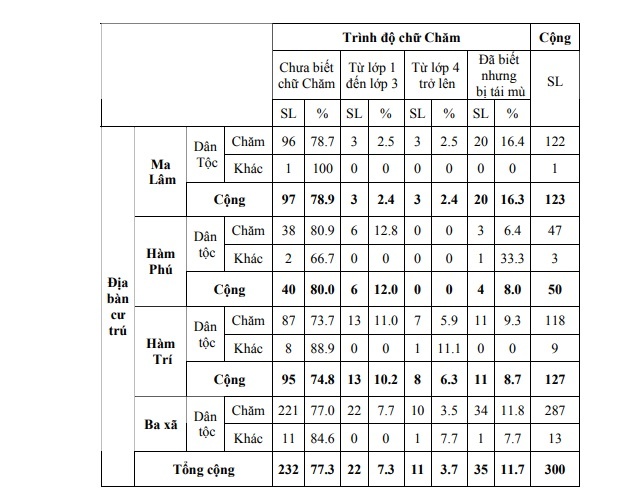
(Nguồn: xử lí phiếu điều tra)
Notes: * SL: Quantity
Graph 2.1: QUALITY OF CARING ONLY BY Ethnicity
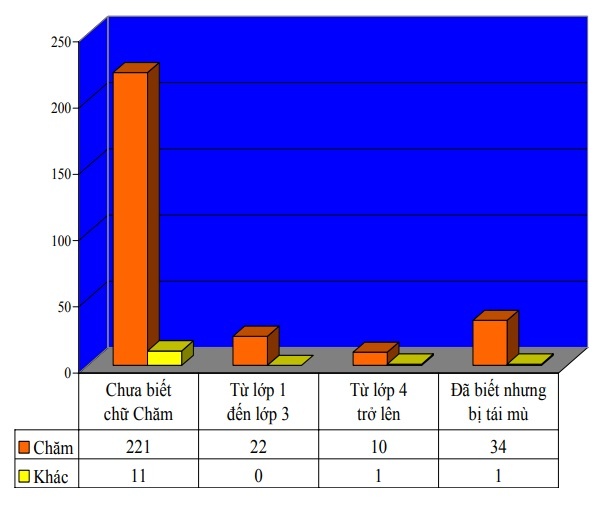
Of the 300 surveyed people, 287 are Cham people, 13 are other ethnic groups ( Kinh, Rai), they are married with Cham people or are teachers working in the 3 communes. investigate.
The survey results show that there are 232 people, accounting for 77.3% of people in the survey age, who are not literate in Cham; 35 people, accounting for 11.7% of the people, were re-blinded. Thus, a total of 89% of people of the surveyed age group are still illiterate in Cham.
In which, the number of Cham people who do not know Cham literate is 221 people, accounting for 77% and the number who know but are illiterate in Cham is 34 people, accounting for 11.8% That shows that the number of Cham illiterate Cham people accounts for a high rate of 88. 8% (nearly 90%) in the Cham community (Table 2.1).
TABLE 2.2: QUALITY OF CARING ONLY BY GENDER
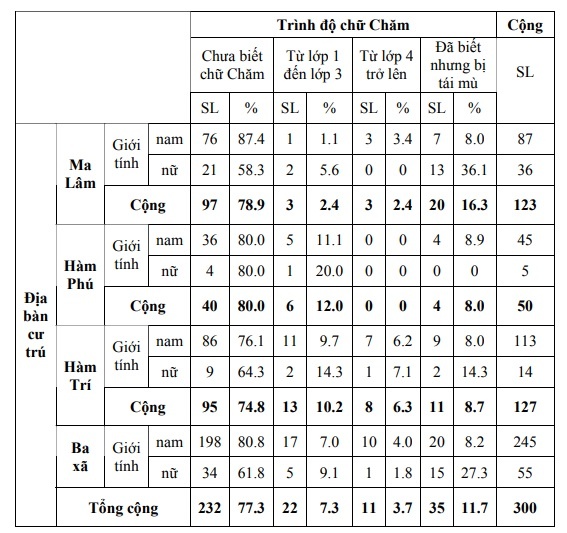
(Source: processing questionnaires)
Graph 2.2: LEVEL OF CARING ONLY BY GENDER
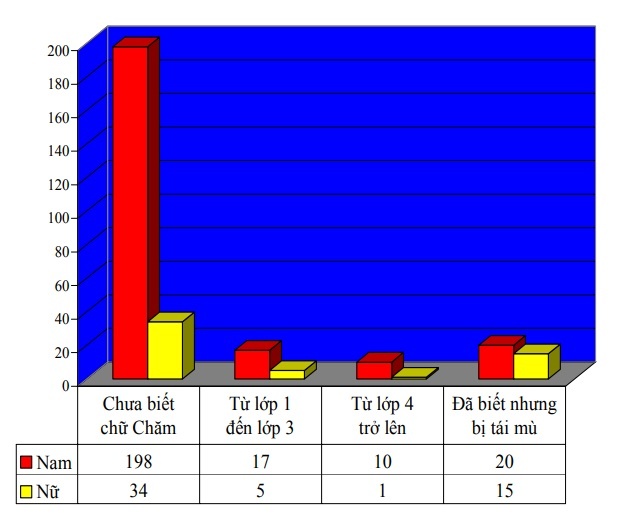
Table 2.2 shows that in the survey, 80.8% of the men were illiterate in Cham and 8.2% of the people were re-illiterated in the Cham. The number of men in both categories is 218/245 people, accounting for 89%. Psychologically, because women often have a lower cultural level and are afraid to contact, most of them refuse to investigate the level of Cham script.
In all three communes, there are only 55 women out of 300 respondents, the majority of these women, who have a higher educational level than the number of other women in the area. Through the survey, women have 61.8% of people who are illiterate in Cham and 27.3% of people who are re-illiterate in Cham. The number of women in both categories is 49/55 people, accounting for 89.1%; In fact, the number of Cham illiterates among women is higher than the survey data.
Thus, the percentage of Cham illiterates among women is only 0.1% higher than that of men. However, in reality, the percentage of Cham illiterates among women will certainly be much higher than the results of the survey. Although the Cham people follow the matrilineal system, the role of women in community activities is still lower than that of men.
Like Kinh women in the past, they still suffer more disadvantages both in terms of family and in society. Cham men are still more knowledgeable about Cham characters, they are still naturally recognized by the Cham community as having the right to be given priority in terms of learning, especially learning Cham characters to conduct religious ceremonies. study the history or customs of the Cham people.
TABLE 2.3: CAREER QUALIFICATIONS BY ACTIVITIES
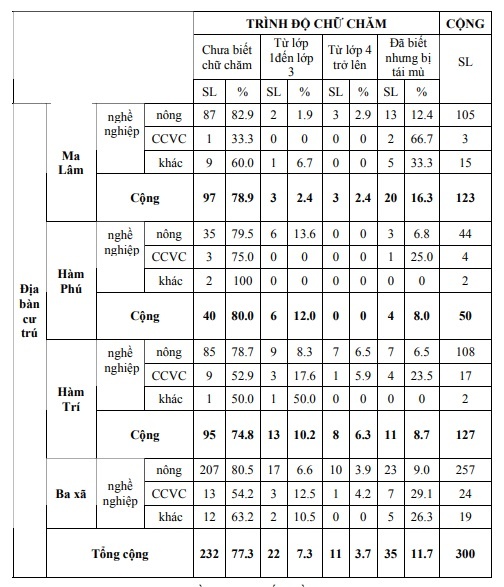
(Source: processing questionnaires)
Note: CCVC: Civil servants.
Graph 2.3: CAREER QUALIFICATIONS BY CAREER
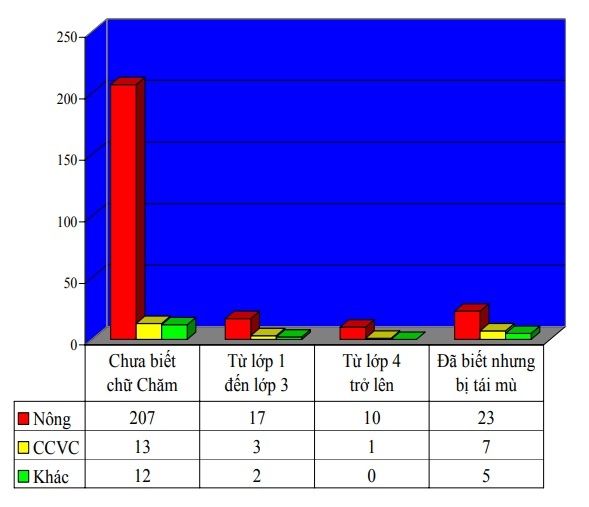
The survey data in Table 2.3 shows that:
Regarding the agricultural component, there are 207 Cham illiterate people (80.5%), 23 are Cham illiterate (9%); Both of these areas are 230/257, accounting for 89.5%. This is the highest Cham illiteracy rate compared to the illiteracy rate among civil servants or other occupations.
For state employees, there are 13 people who do not know Cham literate, accounting for 54.1%; 7 people who were re-illiterated in Cham accounted for 29.1%. Both of these categories are 20 people, accounting for 83.3% of the total 24 civil servants.
Among 19 other occupations participating in the survey, there are 12 Cham illiterate people, accounting for 63.1%; 5 Cham illiterate people accounted for 26.3%. Both of these categories are 17 people, accounting for 89.4% of the total number of people in this profession.
TABLE 2.4: TEACHING LEVELS BY SCHOOL LEVEL
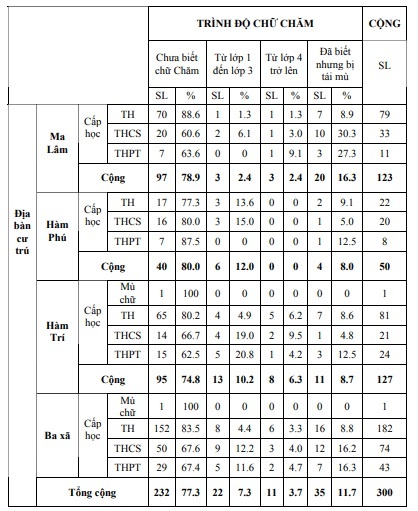
(Source: processing survey data)
Notes: * TH: Primary school; Secondary School: Middle School; High School: High School.
Graph 2.4: LEARNING LEVELS BY SCHOOL LEVEL
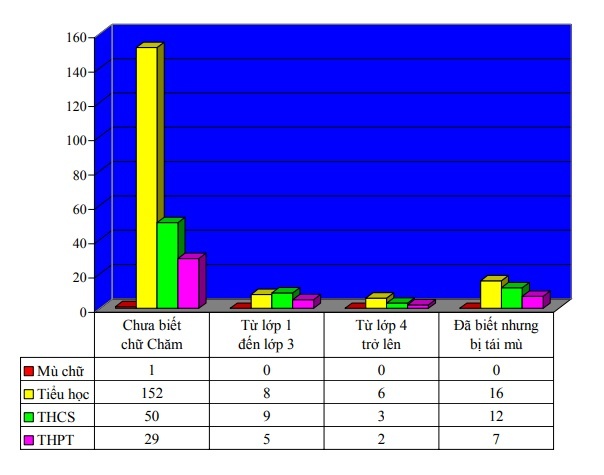
Table 2.4 shows that, out of 300 people surveyed, if calculated by high school level, there is 1 person who is illiterate in general, this person is also illiterate in Cham, accounting for 1/1 (100%); at primary level, there are 168/182 people who are not literate in Cham and are re-illiterate in Cham, accounting for 92.3%; at the lower secondary level, 62/74 people are not literate in Cham and are re-illiterate in Cham, accounting for 83.8%; At the upper secondary level, there are 36/43 people who are not literate in Cham and are re-illiterate in Cham, accounting for 83.7%.
Through the above analysis, it can be concluded that the higher the level of general education, the lower the Cham illiteracy rate. That shows the need to promote the universalization of general literacy education, to create conditions in terms of qualifications and awareness, thereby raising the awareness of learning Cham characters in the Cham community, contributing to implementation of bilingualism in education work in ethnic minority areas.
TABLE 2.5: CAREER LEVELS BY AGE
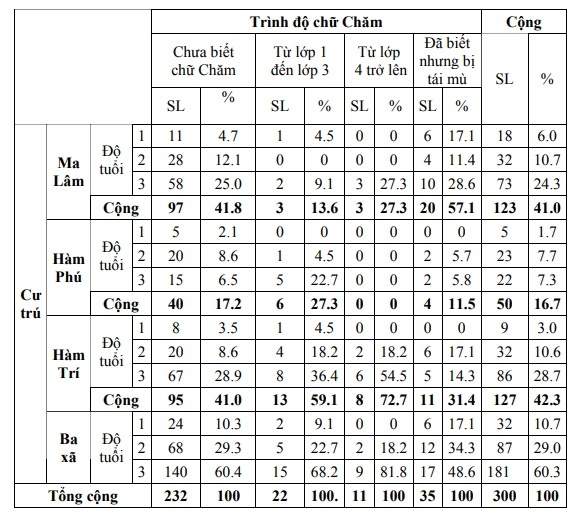
(Source: processing questionnaires)
Notes: * SL: quantity; %: calculate % by column
• 1: Age between 15 – 20
• 2: Age from 21 – 30
• 3: Age from 31 to 45
CHART 2.5: AGE LEVELS ONLY BY AGE
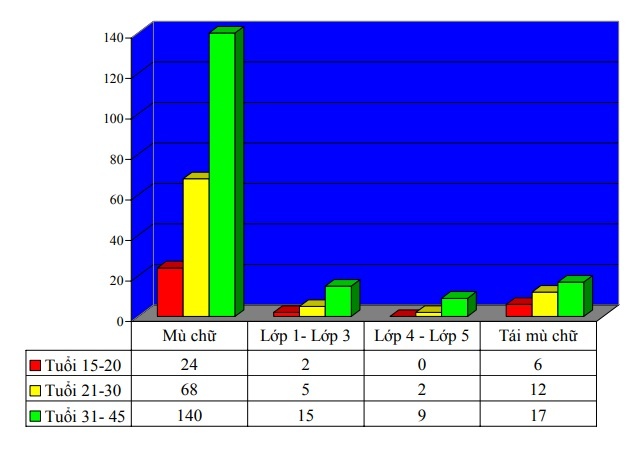
Of the 300 people surveyed:
In the age group of 15 – 20, there are 24 people who are illiterate in Cham out of 32 people, accounting for 75% and 6 people who are completely illiterate, accounting for 18.8%; In both these categories, there are 30 illiterate people out of 32 people, accounting for 93.8% of this age group.






